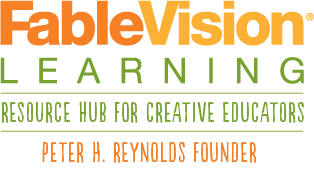Peter H. Reynolds' 8 Tips for Creative Publishing
NY Times best-selling author and illustrator Peter H. Reynolds loves encouraging people to publish their writing and art. Do you have dreams of sharing your creations? Check out the following tips from Peter — and don't wait to take the next steps on your creative journey! Peter writes....
1. Keep a Journal. This may be the single most important thing I ever did to ensure I captured my daily creative thoughts. Many times I would write letters to my daughter Sarah — sharing how I saw the world. This is a great way to focus your writing and spark new ideas. In fact, I drew my book The North Star in my journal. The trick is just getting it down — and then sharing it.
2. Just Do It. It’s the old Nike thing — “just do it.” It’s true. When kids ask me how they can do what I do, I tell them: “Just keep practicing — draw every day — you just keep going — it’s the only way to get better and find your own style."
3. Publishing — Lite. I get nearly daily requests from people trying to “get into the business.” And I advocate for very low-level self-publishing.
Share! Take your story or picture book, even in rough form, and photocopy and staple it. Now do a couple of things. Give a few copies of your book away. Strategically give copies to two or three teachers who teach students at ages that match the level of your story. Or sell them for 50 cents a copy.
If you’re feeling more ambitious, do the web print-on-demand thing. If you can sell 25 copies to friends and relatives, then it’s a sign you’ve got a support network ready to cheer you on. The real test will be if you get requests for additional copies.
4. Go Back to School! If you’re writing children’s books, the most important feedback is from teachers and kids. Go to classrooms, read your work aloud, and talk about how you write and/or draw. Educators love showing kids process. Share with them. What’s your inspiration? Your favorite books? Model your curiosity, exploration, and discovery. By reading your work aloud, you get the reality test — what words are working, and what pictures get the laugh or the “ooh” and “ahh.”
5. Set Goals! If you don’t commit to your creative expression, time slips away and takes with it all the possible art, words, and creation that you could have brought to life. Tell yourself, “This holiday, I am going to have my story done for my children.” Carve out time, schedule it in, and make it a priority!
6. Create Your Ritual. My bedtime has become my ritual time for my daily creativity retreat. I have everything there by my bedside — my little altar — blank journals and pencils, surrounded by books. Stacks of books with words. Stacks of books with no words. Invitations to be inspired.
7. Unleash Imagination. I recently met an artist whose wife and children are also quite artistic. As accomplished as he was with realistic drawing, the artist struggled with one big challenge — imagination. When his kids asked him to draw a dragon, he was stumped. If it didn’t exist in front of him, he couldn’t draw it. I told him, “Think what it is similar to. You do know how to draw a dragon. You can draw a horse, you can draw wings. Now paint it green, and you’re halfway there. Block everything else out and only see that drawing in your head.” I’m drawing in my head.
8. Be Uncareful. Sometimes people never start a project because they’re afraid they’ll make a mistake or it won’t look perfect. This happens with kids and adults, in classrooms and in the workplace. My book The Dot tackles that fear head on. I’m delighted to hear that message resonating with so many people, including art educators around the world who have seen kids pack away their artistic selves, year after year, until only the “class artist” remains. I’m out to change that, and part of my mantra is telling kids (and grown-up kids) to be uncareful! Don’t worry about doing it perfectly — just do it, get it out, experiment, enjoy the happy accidents you’ll inevitably make. My book Ish, sequel to The Dot, tackles how to handle that paralyzing syndrome of trying to “get it right.”
Have you tried any of these tips? Do you have other tips to offer? Comment below to give us insight on how you keep your creative juices flowing.




